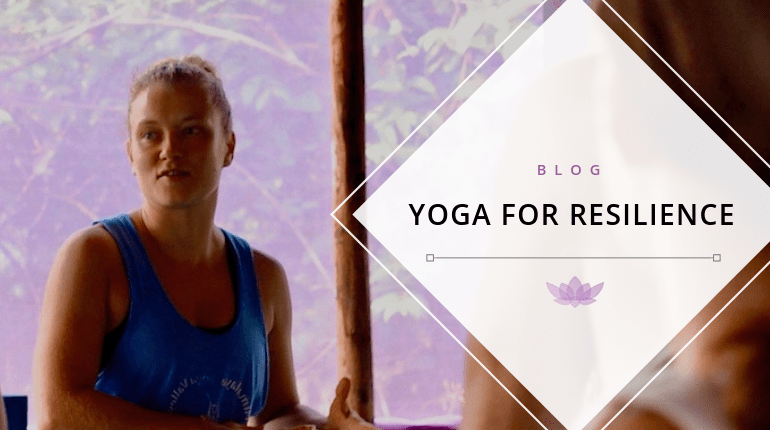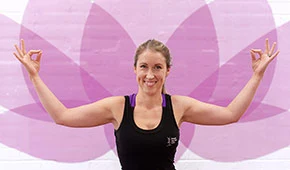
“Do not judge me by my success, judge me by how many times I fell down and got back up again.” ~ Nelson Mandela
Use the quick links below to navigate this article:
– Building Resilience
– Yogic Insights On Resilience
– Cultivating Benificial Behaviors
– Solving Proplems with Communication and Action
– Finding the Roots of our Problems – The Kleshas, Samskaras and Emotions
– Working on Transformation – Patanjali’s Kriya Yoga
– Read and Reflect
– Iswara Pranidhana – Give up Expectations
– Conclusions
Life is hard. It offers a whole range of difficulties from not getting what one wants to different levels of stress relating to work or life in general, all the way up to major life crisis like losing a job, falling ill or even losing a loved one. Some individuals seem to sail through the ups and downs of life with ease and a positive attitude, no matter how devastating their situation might look like from the outside. This inner strength is known as psychological resilience, which stands for the ability to recover from difficulties, hardships and stressful situations and to adapt to changes and uncertainty. Many times words like “bounce back” or “rise up” are used to describe what seems to be happening in the process of resilience – difficulties feel like you’ve fallen down and resilience is the strength which brings you back up on your feet again. This has been studied over the last few decades in the field of positive psychology, which is a branch of psychology that focuses on strengthening the beneficial and positive qualities of individuals rather than fixing what is wrong.
This article will explore how yoga, an ancient Indian philosophical doctrine, can help individuals build resilience. We will gain an understanding of how the philosophy of yoga works and apply this to draw a picture of the methodology that yoga offers for building resilience. The teachings of yoga are at the very heart of resilience, as it discusses the dilemma of human suffering and how to deal with it. We follow Patanjali’s teachings and discuss how the eight-limbed methodology guides us towards cultivating beneficial behaviours through the yamas and the niyamas, the first two limbs, which describe the moral and ethical code of conduct and establish a firm ground for self-development. The concepts of the five kleshas and the samskaras will give us an understanding of the roots of human suffering. The kleshas are the factors that underpin human suffering and the samskaras are the latent imprints of past experiences, forming our habitual patterns. Finally, as a practical methodology for building resilience, the practice of kriya yoga, the yoga of action, is introduced.
Building resilience
“Rock bottom became the solid foundation in which I rebuilt my life.” ~ J.K. Rowling
Generally speaking, all people show traits of resilience. Some people have it more, others less, and anyone can learn it. Studies have shown that several factors contribute to resilience. According to the American Psychological Association (APA) the primary factor in resilience is social support. Caring, supportive and compassionate relationships offer love, a sense of trust, encouragement and reassurance. Additional factors are healthy self-esteem and structured sense of self, good skills in communication and problem solving, ability to take necessary action with a sense of control, commitment and positive future orientation, and capacity to manage impulses and strong feelings. Also, the role of spirituality is mentioned and it has been noted as beneficial in terms of resilience.
The capability to feel positive emotions even at stressful times has also been noted in several studies. Especially emotional memories seem to have an effect on many factors of resilience. Resilient individuals are able to self-generate positive emotions during hardships from positive emotional memories of the past, and the experienced intensity of an event is influenced by them. The regulation of emotions and the outcome of emotions (eg. depression) can be strongly related to a network of emotional memories. These findings altogether support studies that have shown that personality traits might be causally linked with memories.
Psychological resilience has been researched mainly in Western cultures and communities, where individualism and self-reliance are highly valued. In cultures where communities, social groups and religion or spirituality are more valued, like in India, the factors that affect resilience might be different and more about the balance between individual and collective resources.
Yogic insights on resilience
“Yoga allows you to rediscover a sense of wholeness in your life, where you do not feel like you are constantly trying to fit broken pieces together.” ~ B.K.S. Iyengar
The most common problems in our world today stem from emotions like greed, jealousy, anger and intolerance. They weaken our inner strength, stamina and emotional balance, in other words, our resilience. According to Michael Stone, a yoga teacher and a psychotherapist, they are problems of human perception and consciousness and therefore the solution must be derived from transformation and awakening of consciousness. Also, studies have indicated that spirituality brings resilient qualities.
Luckily, yoga has become extremely popular in the Western world over the last decades, but it is still mostly considered to be a relaxing physical workout that is done in gyms and yoga studios. However, originally yoga was a philosophical system, with teachings of self-discovery and awakening the consciousness. The physical workout is a small, supportive part of yoga and only one form of its various practices.
Patanjali’s Yoga Sutras gives a framework for how to practice yoga and explains the outcomes of yoga. The core teachings dive deep into understanding our motivations and behaviour and therefore offers a lot of insights into the psychological conditioning and transformation of human beings. The practice of yoga allows us to see our conditioned way of living and teaches us how to let go of those patterns and transform for the benefit of ourselves and, as a byproduct, others, too.
Patanjali focuses on an eight-limbed (Ashtanga) system of self-discovery. It is a system of yogic practices designed to bring liberation from the patterns of the mind, or in other words, bring awareness and transformation. The limbs are yama (self-restraints), niyama (observances), asana (posture), pranayama (cessation of inhalation and exhalation), pratyahara (sense withdrawal), dharana (one-pointedness of the mind), dhyana (meditation) and samadhi (dropping the sense of self, feeling of oneness).
Before we move on to the discussion of how yoga can contribute to resilience, it is important to note the difference between the concepts of psychology and philosophy in the West and in India. In terms of Western science, psychology and philosophy are separate fields of study. In India, the two are intertwined and Indian philosophy the questions of existence and the matters of the human mind, body and spirit with no separation – the study of human being and the study of the universe are seen as compatible. The essence of Indian philosophy is not so much about an intellectual debate like in the West, it’s more practical and people are encouraged to gain own experience of the teaching through practice. Especially the philosophy of yoga is experiential by nature since there’s no other way to understand the self but through direct experience. Therefore, for example, ethical principles are widely discussed in Indian philosophy and understood as a key player in human behaviour and wellbeing. In the West, the psychology of ethical behaviour would be a separate topic altogether, and ethical codes of conduct are mainly discussed in a professional context as rules of confidence and maintaining respectful relations with clients and patients. On a personal level, the topic seems to be avoided.
Cultivating Beneficial Behaviors – the Yamas and the Niyamas
Social support is the primary factor in resilience along with a strong sense of the self and good self-esteem. However, in the context of yoga, the self would be the starting point. The relationship with the self and with others go hand in hand.
When it comes to relationships, ahimsa (non-violence) is the most important yama, both with the self and with others. Cultivating non-violence brings compassion, friendliness and understanding towards ourselves and others. Santosa (contentment) is highly beneficial attitude, which will complement ahimsa. By cultivating santosa, it is easier to let go of unnecessary expectations and attachments. Svadhyaya (self-study) will reveal our inner selves and it can be supported by external studying of the scriptures, which will guide us through this self-study and inspire us to explore more. Svadhyaya will lead to deeper self-knowledge and is an essential step towards making changes.
The yamas satya and asteya are also helpful. Satya (truthfulness) brings a constant evaluation of thoughts, words and things we do daily – am I being truthful towards others, and towards myself? It will also complement svadhyaya by reminding us to be truthful to ourselves of our own tendencies and qualities. Asteya (non-stealing) will help us reflect on the question “Am I taking something that is not freely given, like someones energy or time? Could I be stealing someones trust, ideas or opportunities? Am I letting someone steal my energy?”. Resilience in relationships is all about building conscious boundaries and recognizing where the fine line between caring and violating boundaries is.
Solving problems with communication and action
Problem-solving and communication skills, and the ability to take necessary action with a sense of control, commitment and positive future orientation were also recognized as a personality trait of a resilient person. Basically, problem-solving boils down to solving things verbally or acting on it. Making decisions and taking necessary action instead of avoiding conflicts, problems or unpleasant duties will bring us closer to whatever we want to get done.
How will yamas and niyamas support that? An excellent example of the yamas and niyamas in action is non-violent communication, which is a protocol of communication developed by psychologist and visionary peacemaker Marshall Rosenberg. Non-violent communications is based on the idea that everybody has the same basic needs, and all conflicts are results of needs not having been met, and more constructive ways of expressing the issue haven’t been available. It is a method where needs are expressed and heard without judgements, diagnosis or demands, using non-invasive language. The goal is to work together in such way that everybody involved will get an opportunity to have their needs heard in a compassionate, collaborative way. It has been used method for example in psychotherapy and conflict areas, so it is fair to say that it is a great tool for solving problems.
For appropriate action, the practice of tapas (discipline) offers a useful insight. Tapas is the burning desire for truth. It will get us going every day, for example, back onto our yoga mats. Tapas will be discussed later on in more detail.
Finding the Roots of our Problems – The Kleshas, Samskaras and Emotions
Resilient people have the ability to manage impulses and strong feelings. They are also able to self-generate positive feelings from emotional memories. In the context of resilience, kleshas and samskaras are involved in managing our impulses and emotions and creating emotional memories.
According to Patanjali’s teachings, the kleshas are five factors that cause human suffering. The factors are avidya (ignorance), raga (desire, grasping), dvesa (aversion), asmita (the story of I, me and mine) and abhinivesa (the fear of death). Avidya refers to not being able to see things as they are, like misunderstanding impermanent (eg. materia) as eternal. Raga and dvesha is a pair of opposites that causes a lot of trouble to human beings – it’s the desire towards what feels good and aversion towards what does not. They are the root of our impulses, the likes and dislikes, and we have the tendency to cling onto these. Saraswati Stone calls asmita the storyteller. It is the mechanism how we create the story of our lives – the ongoing narrative of I, me and mine, which is built around every experience. Abhinivesa is our thirst for further existence, it is the root of our deep fears that cause us to act from fear instead of courage and compassion.
The kleshas produce a wheel of suffering because they reinforce the habitual patterns of human perception and reactivity to external things. The kleshas work through our perception, affecting our experience of everyday life and determining what kind of reaction the experience will trigger. We end up consuming our psychological and physical energy running back and forth avoiding the un-pleasurable, fulfilling our endless desires and trying to keep our story together. In the process, we lose the truth, the present moment, and live a story.
Basically, the kleshas are aspects of our self-centeredness. By letting go of this way of responding to life’s events we will have a more realistic, clear and grounded view of life. That will bring more intelligent action in return. Judith Lasater says our attachments lose their power over us when we become aware of them. Change starts to happen when we start to see ourselves as the narrator of our story and become less identified with the story.
Finally, we arrive at the notion of samskaras, which is a key concept in yoga. Samskaras (latent impressions) are imprints of past painful and pleasurable experiences, which work from the subconsciousness. They can manifest as the beliefs that limit us (like prejudice), habit patterns or as those emotions or reactions that we cannot really point out where they are coming from. Because of samskaras, we don’t really react to the situation at hand, we react to all the past situations that are similar in one way or other. They work like mental, emotional and physical biases, and they reinforce themselves – after repeating something time after time, the imprint becomes deeper and stronger. They are difficult to see, as they are deeply embedded in our views and automatic behaviours.
According to Michael Stone positive samskaras come from positive mental states and negative from negative mental conditions. In order to become more resilient and more capable of self-generating positive emotions, we need to create positive samskaras. It can be something we love to do and inspire us. It can also be affirmation or cultivating beneficial behaviours, a practice or conscious action to change old habits.
Kleshas and sanskaras help us to understand individuals ability to feel and to self-generate beneficial behaviours. That way, our impulses and emotions caused by them become easier to handle and we will be able to create beneficial samskaras, and in turn, we become more resilient.
Working on Transformation – Patanjali’s Kriya Yoga
Patanjali also talks about kriya yoga, the path of action, which is meant especially for thinning out the kleshas. Kriya yoga consists of tapas (discipline), svadhyaya (self-study) and iswara pranidhana (surrendering to the God or the universal truth). These terms are familiar as the niyamas, but in the practice of kriya yoga they get a special role as the spine of our yoga practice.
Tapas – Take responsibility
Tapas is often referred to as self-discipline or heat, as already mentioned earlier. In the context of kriya yoga it can be seen as the way we perform our actions. Being disciplined means taking responsibility for ourselves, our actions and our practice. When we cultivate tapas, we grow to be independent and determined and learn to take conscious action instead of following something with blind faith or reacting impulsively.
Judith Lasater describes our practice, eg. asana practice, as discipline in action. It is important to be realistic, honest (satya), about what we can do, and fully commit to doing it well. Tapas is made of consistency, not quantity. If a person knows she can realistically do a five-minute meditation each day, then it’s better than struggling with anything more than that. Only a consistent practice will make changes in habit patterns, while excessive quantity can have the opposite effects. Tapas is the patience to act, practice and be with whatever is in this moment, which contributes to resilience as the ability to take appropriate action.
Svadhyaya – Read and reflect
Svadhyaya means self-study which is interpreted either as a detailed study of self or studying the scriptures. As kriya yoga practice, it can mean taking time for studying, meditation, writing a reflective journal or contemplating any insights gained from these activities.
Studying the self involves all the aspects: the physical, the mental, the emotional and the spiritual self. In asana practice, it is the meditative way of practice and the constant studying of the body and responses of the mind, rhythm of the breath and flow of energy.
Studying the scriptures can be studying important yoga literature, like the yoga sutras, Bhagavad Gita or commentary on these. It can be any form of studying that will support spiritual growth. Reading and studying give knowledge and inspiration, and it will unite the philosophical and practical sides of yoga together.
Svadhyaya leads to a stronger sense of self, a more realistic self-image, and then ultimately leads to greater resilience.
Take our 10 Day Yoga Challenge: Svadhyaya Sankalpha
Iswara pranidhana – Give up expectations
The third practice of kriya yoga is iswara pranidhana, which means surrendering to the higher truth, to life itself. As a kriya yoga practice, it is performing all the actions with devotion as offering to the higher truth, without any expectations of the results. It is giving up the attachment to the fruits of achievements.
Basically, the practice of iswara pranidhana brings faith in what one does and faith in spiritual growth. It can also result in a superior quality of work – if you were to offer something to the highest of all, you would always do your best. Accepting the outcomes are with contentment (santosa) brings clarity and balance, when there’s no stress of failure or indeed an achievement. In our asana practice, this can mean doing our practice without pushing towards nailing the next asana, without labels of “good” or “bad” practice, without judgements, just having faith to the practice. Then the practice transforms into a physical celebration of life.
Iswara pranidhana will bring more positive emotions, as there’s no more failure or success – there’s only action performed as service. This will bring more resilience and ability to self-generate positive emotions. Together with proper tapas and thorough svadhyaya, they form a vehicle to transformation.
Conclusions
Yoga offers a highly structured way to work on building resilience. The method of yoga philosophy is to understand the roots of the reasons why we might lose our inner strength. The solution is building healthier roots, allowing us to grow stronger. For a person who wants to build resilience, the yamas and niyamas provide a solid ground for reflection and insights on how to deal with others and challenging situations. Awareness of the kleshas brings light on own behaviour and impulses and emotions. Understanding the mechanism of samskaras allows us to break free from the habitual reactions and mental conditioning. With the practice of kriya yoga we can become more resilient by increasing our responsibility, understanding ourselves better and giving up the craving for achievements.
The process of building resilience with the help of yoga is not a linear process. It works like a spiral, where similar concepts occur on different levels of human experience, penetrating our lives from different angles and showing different points of view and deeper insights.
One of the purposes of this article was to find out can yoga philosophy offer insights and solutions for topics studied in Western psychology. My outcome was that it is possible, although it requires a lot of interpretation. The Western research on yoga concentrates solely on the physical practice and the research on yoga philosophy is missing. I see huge potential in the psychological insights of yoga and I hope to see more research in that field in the future.
Meiju Mäkinen
Himalaya Yoga Valley Level I Graduate and Yoga Intern







